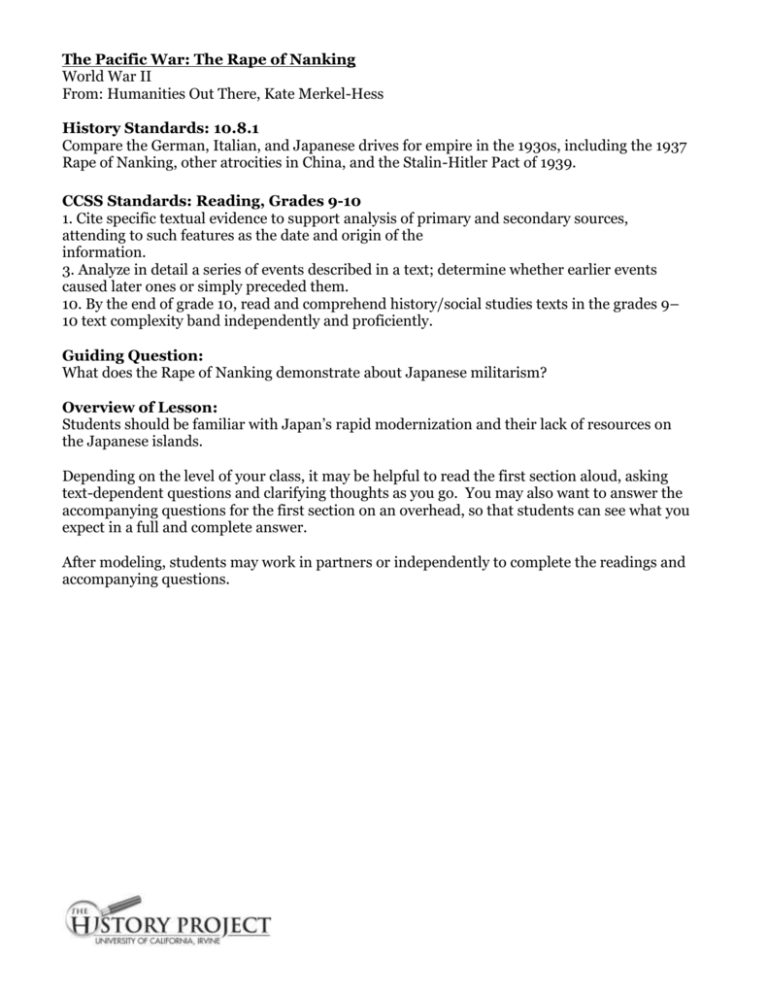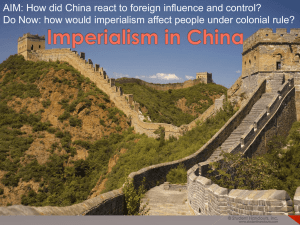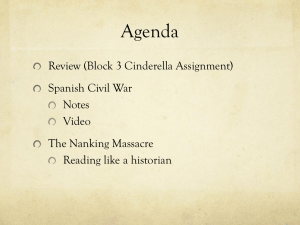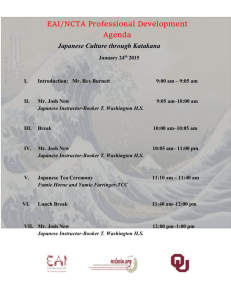Pacific War - Rape of Nanking
advertisement

The Pacific War: The Rape of Nanking World War II From: Humanities Out There, Kate Merkel-Hess History Standards: 10.8.1 Compare the German, Italian, and Japanese drives for empire in the 1930s, including the 1937 Rape of Nanking, other atrocities in China, and the Stalin-Hitler Pact of 1939. CCSS Standards: Reading, Grades 9-10 1. Cite specific textual evidence to support analysis of primary and secondary sources, attending to such features as the date and origin of the information. 3. Analyze in detail a series of events described in a text; determine whether earlier events caused later ones or simply preceded them. 10. By the end of grade 10, read and comprehend history/social studies texts in the grades 9– 10 text complexity band independently and proficiently. Guiding Question: What does the Rape of Nanking demonstrate about Japanese militarism? Overview of Lesson: Students should be familiar with Japan’s rapid modernization and their lack of resources on the Japanese islands. Depending on the level of your class, it may be helpful to read the first section aloud, asking text-dependent questions and clarifying thoughts as you go. You may also want to answer the accompanying questions for the first section on an overhead, so that students can see what you expect in a full and complete answer. After modeling, students may work in partners or independently to complete the readings and accompanying questions. The Pacific War: The Rape of Nanking Part One: Where and What Was the “Rape of Nanking”? This map is from a guidebook published in 1912 (Madrolle's Guide Books: Northern China, The Valley of the Blue River, Korea. Hachette & Company, 1912). Can you locate Shanghai (a name which, in Chinese, literally means “on the sea”)? Nanking (today called Nanjing) is upriver from Shanghai. Can you find it? Why is it called “The Rape of Nanking”? The word “rape” has two primary meanings. Today, we generally use this word to describe sexual assault. However, an older meaning of the word “rape” references the more general violations of war, like the looting, destruction, and killing the Japanese military conducted in Nanking. This is a meaning that is very little used today—when you use the word, people will assume you mean violent sexual assault, and not the older, more general meaning. It is important to note that in the case of Nanking, both meanings are relevant. In addition to killing at least 100,000 people and perhaps as many as 300,000, and destroying a great amount of property in Nanking, the Japanese military also raped between 20,000 and 80,000 women in the days following the fall of Nanking. The number estimates vary so widely because few records were kept of those killed, and many rape victims were either killed after being raped, or were too ashamed to come forward and talk about what had happened to them. Part Two: What Happened in Nanking? The second hand-out you received today is a reproduction of an article published by the New York Times, a widely circulated paper then and now, on December 18, 1937, five days after the Japanese entered Nanking. It was one of the first detailed reports Americans could read about what was happening in Nanking. A historian reading this article would be interested in two things: the content of the article and its source. This means that the historian would be interested in understanding what the article describes, or what kind of facts he or she could gather from the article. A historian would also, however, want to understand the point of view of the article’s author and discover how that author knew the things he or she wrote about. Please first look at the first paragraph of the article. When was the article submitted for publication, and from where? Now read the bracketed excerpts from the article, then answer the following questions. 1. What sources did the author use? Underline those sentences that indicate how the author learned the facts he reported. New Words bayonet: a steel blade attached to the end of a rifle roving: moving, wandering 2. As far as you can tell, which of the following groups of people were not victims of the Japanese soldiers? a) People who ran away from soldiers or were out late at night b) Policemen and firemen c) Foreigners d) Chinese soldiers plundering: the act of looting impressed: forced into service wholesale: entire cowed: intimidated, with one’s courage destroyed interned: confined en masse: as a whole Modern History Sourcebook: The Nanking Massacre, 1937 The Japanese occupation of Nanking, the capital of the Republic of China, lead to one of the greatest horrors of the century . This eyewitness report was filed by a New York Times reporter. Aboard the U.S.S. Oahu at Shanghai, Dec. 17 [1937]. Through wholesale atrocities and vandalism at Nanking the Japanese Army has thrown away a rare opportunity to gain the respect and confidence of the Chinese inhabitants and of foreign opinion there.... The killing of civilians was widespread. Foreigners who traveled widely through the city Wednesday found civilian dead on every street. Some of the victims were aged men, women and children. Policemen and firemen were special objects of attack. Many victims were bayoneted and some of the wounds were barbarously cruel. Any person who ran because of fear or excitement was likely to be killed on the spot as was any one caught by roving patrols in streets or alleys after dark. Many slayings were witnessed by foreigners. The Japanese looting amounted almost to plundering of the entire city. Nearly every building was entered by Japanese soldiers, often under the eyes of their officers, and the men took whatever they wanted. The Japanese soldiers often impressed Chinese to carry their loot.... The mass executions of war prisoners added to the horrors the Japanese brought to Nanking. After killing the Chinese soldiers who threw down their arms and surrendered, the Japanese combed the city for men in civilian garb who were suspected of being former soldiers. In one building in the refugee zone 400 men were seized. They were marched off, tied in batches of fifty, between lines of riflemen and machine gunners, to the execution ground. Just before boarding the ship for Shanghai the writer watched the execution of 200 men on the Bund [dike]. The killings took ten minutes. The men were lined against a wall and shot. Then a number of Japanese, armed with pistols, trod nonchalantly around the crumpled bodies, pumping bullets into any that were still kicking. The army men performing the gruesome job had invited navy men from the warships anchored off the Bund to view the scene. A large group of military spectators apparently greatly enjoyed the spectacle. When the first column of Japanese troops marched from the South Gate up Chungshan Road toward the city's Big Circle, small knots of Chinese civilians broke into scattering cheers, so great was their relief that the siege was over and so high were their hopes that the Japanese would restore peace and order. There are no cheers in Nanking now for the Japanese. By despoiling the city and population the Japanese have driven deeper into the Chinese a repressed hatred that will smolder through tears as forms of the anti-Japanism that Tokyo professes to be fighting to eradicate from China. The capture of Nanking was the most overwhelming defeat suffered by the Chinese and one of the most tragic military debacles in the history of modern warfare. In attempting to defend Nanking the Chinese allowed themselves to be surrounded and then systematically slaughtered.... The flight of the many Chinese soldiers was possible by only a few exits. Instead of sticking by their men to hold the invaders at bay with a few strategically placed units while the others withdrew, many army leaders deserted, causing panic among the rank and file. Those who failed to escape through the gate leading to Hsiakwan and from there across the Yangtze were caught and executed.... When the Japanese captured Hsiakwan gate they cut off all exit from the city while at least a third of the Chinese Army still was within the walls. Because of the disorganization of the Chinese a number of units continued fighting Tuesday noon, many of these not realizing the Japanese had surrounded them and that their cause was hopeless. Japanese tank patrols systematically eliminated these. Tuesday morning, while attempting to motor to Hsiakwan, I encountered a desperate group of about twenty-five Chinese soldiers who were still holding the Ningpo Guild Building on Chungahan Road. They later surrendered. Thousands of prisoners were executed by the Japanese. Most of the Chinese soldiers who had been interned in the safety zone were shot in masses. The city was combed in a systematic house-to-house search for men having knapsack marks on their shoulders or other signs of having been soldiers. They were herded together and executed. Many were killed where they were found, including men innocent of any army connection and many wounded soldiers and civilians. I witnessed three mass executions of prisoners within a few hours Wednesday. In one slaughter a tank gun was turned on a group of more than 100 soldiers at a bomb shelter near the Ministry of Communications. A favorite method of execution was to herd groups of a dozen men at entrances of dugout and to shoot them so the bodies toppled inside. Dirt then was shoveled in and the men buried. Since the beginning of the Japanese assault on Nanking the city presented a frightful appearance. The Chinese facilities for the care of army wounded were tragically inadequate, so as early as a week ago injured men were seen often on the streets, some hobbling, others crawling along seeking treatment. Civilian casualties also were heavy, amounting to thousands. The only hospital open was the American managed University Hospital and its facilities were inadequate for even a fraction of those hurt. Nanking's streets were littered with dead. Sometimes bodies had to be moved before automobiles could pass. The capture of Hsiakwan Gate by the Japanese was accompanied by the mass killing of the defenders, who were piled up among the sandbags, forming a mound six feet high. Late Wednesday the Japanese had not removed the dead, and two days of heavy military traffic had been passing through, grinding over the remains of men, dogs and horses. The Japanese appear to want the horrors to remain as long as possible, to impress on the Chinese the terrible results of resisting Japan. Chungahan Road was a long avenue of filth and discarded uniforms, rifles, pistols, machine guns, fieldpieces, knives and knapsacks. In some places the Japanese had to hitch tanks to debris to clear the road. ____________________________________________________________________________ From F. Tillman, "All Captives Slain,'' The New York Times, December 18, 1937, pp. 1, 10. This text is part of the Internet Modern History Sourcebook. The Sourcebook is a collection of public domain and copy-permitted texts for introductory level classes in modern European and World history. Unless otherwise indicated the specific electronic form of the document is copyright. Permission is granted for electronic copying, distribution in print form for educational purposes and personal use. If you do reduplicate the document, indicate the source. No permission is granted for commercial use of the Sourcebook. (c)Paul Halsall Aug 1997 halsall@murray.fordham.edu Part Three: Primary v. Secondary Sources While doing research, a historian often looks at both primary sources and secondary sources. A primary source is a document or object in its original form. It is created by people at the time of an event. Examples of primary sources are diaries, letters and e-mails, government documents, oral histories, surveys, and works of art. Your textbook is an example of a secondary source. A secondary source provides analysis or interprets a historical event. Secondary sources often rely on primary sources for information and evidence. Examples of secondary sources include encyclopedias, documentaries, and scholarly articles. Please read the following passage from the diary of Japanese soldier Azuma Shiro describing the surrender of Chinese troopsi, and then answer the questions: They all walked in droves, like ants crawling on the ground. They looked like a bunch of homeless people, with ignorant expressions on their faces. A herd of ignorant sheep, with no rule or order, marched on in the darkness, whispering to each other… It felt quite foolish to think we had been fighting to the death against these ignorant slaves. And some of them were even twelve- or thirteen-year-old boys. 1. Is this a primary or secondary source? How do you know? 2. Why do you think this soldier might make these comparisons between animals and Chinese troops? Please write below the comparisons Azuma Shiro makes between Chinese people and animals or broader categories of people. The following passage is from testimony given by a Japanese private named Tajimaii: One day Second Lieutenant Ono said to us, “You have never killed anyone yet, so today we shall have some killing practice. You must not consider the Chinese as a human being, but only as something of rather less value than a dog or cat. Be brave! Now, those who wish to volunteer for killing practice, step forward.” No one moved. The lieutenant lost his temper. “You cowards!” he shouted. “Not one of you is fit to call himself a Japanese soldier. So no one will volunteer? Well then, I’ll order you.” And he began to call out names. “Otani—Furukawa— Ueno—Tajima!” (My God—me too!) I raised my bayoneted gun with trembling hands and—directed by the lieutenant’s almost hysterical cursing—I walked slowly towards the terror-stricken Chinese standing beside the pit—the grave he had helped to dig. In my heart, I begged his pardon, and—with my eyes shut and the lieutenant’s curses in my ears—I plunged the bayonet into the petrified Chinese. When I opened my eyes again, he had slumped down into the pit. “Murderer! Criminal!” I called myself. 3. Is this a primary or a secondary source? How do you know? 4. Please list the examples in this passage of comparisons between the Chinese people and animals as well. 5. How do you think the author of this passage feels about such comparisons? Do you think his point of view changed between when he was a soldier and when he gave his testimony? 6. Look again at the second handout, the article you read earlier from the New York Times. Is this a primary or secondary source? Now open your textbook to page 338. Is the description there of the Japanese invasion of China a primary or secondary document? What about the map? Is it a primary or secondary source? Part Four: Primary Sources in Your Life Please list below all the things you have done since you came to class yesterday (i.e., all the things you have done in the past 24 hours) Now imagine that a historian in 100 years wants to know how you spent the last day. What sources might he or she use to reconstruct your activities? Make a note beside each activity of the documents you might leave behind, or the other sources a historian might use to better understand your life and your point of view. i ii Excerpted from Iris Chang, The Rape of Nanking. New York: Basic Books, 1997. From Dick Wilson, When Tigers Fight. New York: Viking Press, 1982.









